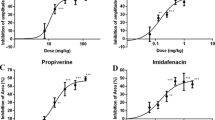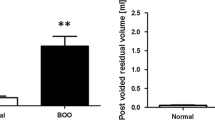Abstract
Imidafenacin (KRP-197) is a novel antimuscarinic agent for overactive bladder treatment. The inhibitory effect of imidafenacin on detrusor contraction has been adopted for assessing their bladder selectivity, but this is becoming less convincing as an effectiveness index. We, therefore, reevaluated the bladder selectivity of imidafenacin and other antimuscarinics using their effects on the bladder capacity as an effectiveness index. Bladder capacity was measured by intermittent cystometry in urethane-anesthetized rats. In the tissues related to antimuscarinic side effects, the inhibitory actions were measured each on salivary secretion by electrical stimulation of chorda tympani, on rhythmical contractions in colon, and on carbamylcholine-induced bradycardia. Imidafenacin, solifenacin succinate, tolterodine tartrate, and propiverine hydrochloride significantly increased the bladder capacity, with minimum effective doses of 0.003, 1, 0.03, and 3 mg/kg (i.v.), respectively. The antimuscarinics tested, except for propiverine hydrochloride, shared a common property of increasing bladder capacity at a dose which did not affect micturition pressure. The relative bladder selectivity of imidafenacin, solifenacin succinate, and tolterodine tartrate was 15-, 1.7-, and 2.5-fold higher over salivary gland; 150-, 1.9-, and 9.2-fold higher over colon; and 50-, 12-, and 4.6-fold higher over heart, respectively, than that of propiverine hydrochloride. Thus, imidafenacin shows the most highly selective for bladder over the tissues related to major antimuscarinic side effects, compared to the other three well-known antimuscarinics tested in the rat.







Similar content being viewed by others
Abbreviations
- OAB:
-
Overactive bladder
- ACh:
-
Acetylcholine
- CCh:
-
Carbamylcholine
- BP:
-
Blood pressure
- HR:
-
Heart rate
- SNP:
-
Sodium nitroprusside
References
Abrams P, Andersson KE (2007) Muscarinic receptor antagonists for overactive bladder. BJU Int 100:987–1006
Abrams P, Cardozo L, Fall M, Griffiths D, Rosier P, Ulmsten U, van Kerrebroeck P, Victor A, Wein A, Standardisation Sub-committee of the International Continence Society (2002) The standardisation of terminology of lower urinary tract function: report from the Standardisation Sub-committee of the International Continence Society. Neurourol Urodyn 21:167–178
Abrams P, Andersson KE, Buccafusco JJ, Chapple C, de Groat WC, Fryer AD, Kay G, Laties A, Nathanson NM, Pasricha PJ, Wein AJ (2006) Muscarinic receptors: their distribution and function in body systems, and the implications for treating overactive bladder. Br J Pharmacol 148:565–578
Akino H, Namiki M, Suzuki K, Fuse H, Yokoyama O (2009) Treatment satisfaction with antimuscarinics: which type of drug is desirable to patients with OAB? J Urol 181(Suppl):675
Andersson KE (1999) Advances in the pharmacological control of the bladder. Exp Physiol 84:195–213
Andersson KE, Olshansky B (2007) Treating patients with overactive bladder syndrome with antimuscarinics: heart rate considerations. BJU Int 100:1007–1014
Andersson KE, Yoshida M (2003) Antimuscarinics and the overactive detrusor—which is the main mechanism of action? Eur Urol 43:1–5
Chapple CR, Nilvebrant L (2002) Tolterodine: selectivity for the urinary bladder over the eye (as measured by visual accommodation) in healthy volunteers. Drugs R D 3:75–81
El-Mas MM, Afify EA, Omar AG, Sharabi FM (2002) Cyclosporine adversely affects baroreflexes via inhibition of testosterone modulation of cardiac vagal control. J Pharmacol Exp Ther 301:346–354
Finney SM, Andersson KE, Gillespie JI, Stewart LH (2006) Antimuscarinic drugs in detrusor overactivity and the overactive bladder syndrome: motor or sensory actions? BJU Int 98:503–507
Gillespie JI, van Koeveringe GA, de Wachter SG, de Vente J (2009) On the origins of the sensory output from the bladder: the concept of afferent noise. BJU Int 103:1324–1333
Hedlund P, Streng T, Lee T, Andersson KE (2007) Effects of tolterodine on afferent neurotransmission in normal and resiniferatoxin treated conscious rats. J Urol 178:326–331
Hegde SS (2006) Muscarinic receptors in the bladder: from basic research to therapeutics. Br J Pharmacol 147(Suppl 2):S80–S87
Homma Y, Yamaguchi O, Imidafenacin Study Group (2009) A randomized, double-blind, placebo- and propiverine-controlled trial of the novel antimuscarinic agent imidafenacin in Japanese patients with overactive bladder. Int J Urol 16:499–506
Igawa Y, Zhang X, Nishizawa O, Umeda M, Iwata A, Taketo MM, Manabe T, Matsui M, Andersson KE (2004) Cystometric findings in mice lacking muscarinic M2 or M3 receptors. J Urol 172:2460–2464
Iijima K, De Wachter S, Wyndaele JJ (2007) Effects of the M3 receptor selective muscarinic antagonist darifenacin on bladder afferent activity of the rat pelvic nerve. Eur Urol 52:842–847
Ikeda K, Kobayashi S, Suzuki M, Miyata K, Takeuchi M, Yamada T, Honda K (2002) M3 receptor antagonism by the novel antimuscarinic agent solifenacin in the urinary bladder and salivary gland. Naunyn Schmiedebergs Arch Pharmacol 366:97–103
Kim Y, Yoshimura N, Masuda H, de Miguel F, Chancellor MB (2005) Antimuscarinic agents exhibit local inhibitory effects on muscarinic receptors in bladder-afferent pathways. Urology 65:238–242
Kobayashi F, Yageta Y, Segawa M, Matsuzawa S (2007a) Effects of imidafenacin (KRP-197/ONO-8025), a new anti-cholinergic agent, on muscarinic acetylcholine receptors. High affinities for M3 and M1 receptor subtypes and selectivity for urinary bladder over salivary gland. Arzneimittelforschung 57:92–100
Kobayashi F, Yageta Y, Yamazaki T, Wakabayashi E, Inoue M, Segawa M, Matsuzawa S (2007b) Pharmacological effects of imidafenacin (KRP-197/ONO-8025), a new bladder selective anti-cholinergic agent, in rats. Comparison of effects on urinary bladder capacity and contraction, salivary secretion and performance in the Morris water maze task. Arzneimittelforschung 57:147–154
La Rovere MT, Pinna GD, Hohnloser SH, Marcus FI, Mortara A, Nohara R, Bigger JT Jr, Camm AJ, Schwartz PJ, Investigators ATRAMI, Tone A, Infarcton Reflexes After Myocardial (2001) Baroreflex sensitivity and heart rate variability in the identification of patients at risk for life-threatening arrhythmias: implications for clinical trials. Circulation 103:2072–2077
Li M, Johnson CP, Adams MB, Sarna SK (2002) Cholinergic and nitrergic regulation of in vivo giant migrating contractions in rat colon. Am J Physiol Gastrointest Liver Physiol 283:G544–G552
Mansfield KJ (2010) Muscarinic receptor antagonists, the overactive bladder and efficacy against urinary urgency. Clin Med Insight: Ther 2:471–480
Mansfield KJ, Liu L, Mitchelson FJ, Moore KH, Millard RJ, Burcher E (2005) Muscarinic receptor subtypes in human bladder detrusor and mucosa, studied by radioligand binding and quantitative competitive RT-PCR: changes in ageing. Br J Pharmacol 144:1089–1099
McNamara A, Pulido-Rios MT, Sweazey S, Obedencio GP, Thibodeaux H, Renner T, Armstrong SR, Steinfeld T, Hughes AD, Wilson RD, Jasper JR, Mammen M, Hegde SS (2009) Pharmacological properties of TD-6301, a novel bladder selective muscarinic receptor antagonist. Eur J Pharmacol 605:145–152
Nomura N, Kaneko S, Hamakawa T, Nagai M, Iriki M (1989) Effects of propiverine hydrochloride (P-4) and its metabolites on urinary bladder function in anesthetized rats. Folia Pharmacol Jpn 94:173–180
Ohno T, Nakade S, Nakayama K, Kitagawa J, Ueda S, Miyabe H, Masuda Y, Miyata Y (2008) Absolute bioavailability of imidafenacin after oral administration to healthy subjects. Br J Clin Pharmacol 65:197–202
Ohtake A, Ukai M, Hatanaka T, Kobayashi S, Ikeda K, Sato S, Miyata K, Sasamata M (2004) In vitro and in vivo tissue selectivity profile of solifenacin succinate (YM905) for urinary bladder over salivary gland in rats. Eur J Pharmacol 492:243–250
Ohtake A, Sato S, Ikeda K, Sasamata M, Miyata K (2006) Pharmacological and clinical profile of solifenacin succinate (Vesicare) developed as a new therapeutic agent for overactive bladder. Folia Pharmacol Jpn 128:425–432
Ohtake A, Saitoh C, Yuyama H, Ukai M, Okutsu H, Noguchi Y, Hatanaka T, Suzuki M, Sato S, Sasamata M, Miyata K (2007) Pharmacological characterization of a new antimuscarinic agent, solifenacin succinate, in comparison with other antimuscarinic agents. Biol Pharm Bull 30:54–58
Oki T, Yamada S, Tohma A, Kimura R (2001) Muscarinic receptor binding characteristics in rat tissues after oral administration of oxybutynin and propiverine. Biol Pharm Bull 24:491–495
Oki T, Sato S, Miyata K, Yamada S (2005) Muscarinic receptor binding, plasma concentration and inhibition of salivation after oral administration of a novel antimuscarinic agent, solifenacin succinate in mice. Br J Pharmacol 145:219–227
Olshansky B, Sabbah HN, Hauptman PJ, Colucci WS (2008) Parasympathetic nervous system and heart failure: pathophysiology and potential implications for therapy. Circulation 118:863–871
Sinha S, Gupta S, Malhotr S, Krishna NS, Meru AV, Babu V, Bansal V, Garg M, Kumar N, Chugh A, Ray A (2010) AE9C90CB: a novel, bladder-selective muscarinic receptor antagonist for the treatment of overactive bladder. Br J Pharmacol 160:1119–1127
Sugisawa M, Takai N (1991) The role of substance P in parasympathetic nerve-induced secretion in the rat submandibular gland. J Osaka Dent Univ 25:51–62
Suzuki M, Ohtake A, Yoshino T, Yuyama H, Hayashi A, Ukai M, Okutsu H, Noguchi Y, Sato S, Sasamata M (2005) Effects of solifenacin succinate (YM905) on detrusor overactivity in conscious cerebral infarcted rats. Eur J Pharmacol 512:61–66
Takagi-Matsumoto H, Ng B, Tsukimi Y, Tajimi M (2004) Effects of NSAIDs on bladder function in normal and cystitis rats: a comparison study of aspirin, indomethacin, and ketoprofen. J Pharmacol Sci 95:458–465
Wada Y, Yoshida M, Kitani K, Kikukawa H, Ichinose A, Takahashi W, Gotoh S, Inadome A, Machida J, Ueda S (1995) Comparison of the effects of various anticholinergic drugs on human isolated urinary bladder. Arch Int Pharmacodyn Ther 330:76–89
Wess J, Angeli P, Melchiorre C, Moser U, Mutschler E, Lambrecht G (1988) Methoctramine selectively blocks cardiac muscarinic M2 receptors in vivo. Naunyn Schmiedebergs Arch Pharmacol 338:246–249
Yamada S, Seki M, Ogoda M, Fukata A, Nakamura M, Ito Y (2011) Selective binding of bladder muscarinic receptors in relation to the pharmacokinetics of a novel antimuscarinic agent, imidafenacin, to treat overactive bladder. J Pharmacol Exp Ther 336:365–371
Yamaguchi O (2010) Antimuscarinics and overactive bladder: other mechanism of action. Neurourol Urodynam 29:112–115
Yokoyama O, Yusup A, Miwa Y, Oyama N, Aoki Y, Akino H (2005) Effects of tolterodine on an overactive bladder depend on suppression of C-fiber bladder afferent activity in rats. J Urol 174:2032–2036
Yokoyama O, Tanaka I, Kusukawa N, Yamauchi H, Ito H, Aoki Y, Oyama N, Miwa Y, Akino H (2011) Antimuscarinics suppress adenosine triphosphate and prostaglandin E2 release from urothelium with potential improvement in detrusor overactivity in rats with cerebral infarction. J Urol 185:2392–2397
Yoshida M, Masunaga K, Nagata T, Yono M, Homma Y (2010) The forefront for novel therapeutic agents based on the pathophysiology of lower urinary tract dysfunction: pathophysiology and pharmacotherapy of overactive bladder. J Pharmacol Sci 112:128–134
Zinner N, Tuttle J, Marks L (2005) Efficacy and tolerability of darifenacin, a muscarinic M3 selective receptor antagonist (M3 SRA), compared with oxybutynin in the treatment of patients with overactive bladder. World J Urol 23:248–252
Acknowledgments
We thank Mr. Someya K and Mr. Yasue T for their helpful comments on the manuscript.
Conflict of interest
All authors are employees of Kyorin Pharmaceuticals Co., Ltd. The company funded and approved the conduct of the study. The authors conducted the study at their own discretion and had editorial freedom with respect to the manuscript. The authors will not receive any monetary reward from the company even after the manuscript is accepted.
Author information
Authors and Affiliations
Corresponding author
Rights and permissions
About this article
Cite this article
Yamazaki, T., Muraki, Y. & Anraku, T. In vivo bladder selectivity of imidafenacin, a novel antimuscarinic agent, assessed by using an effectiveness index for bladder capacity in rats. Naunyn-Schmiedeberg's Arch Pharmacol 384, 319–329 (2011). https://doi.org/10.1007/s00210-011-0675-1
Received:
Accepted:
Published:
Issue Date:
DOI: https://doi.org/10.1007/s00210-011-0675-1




